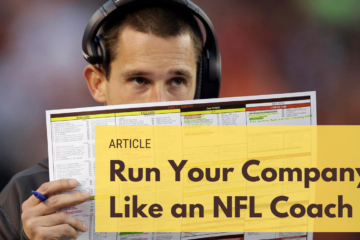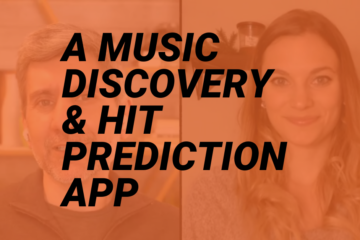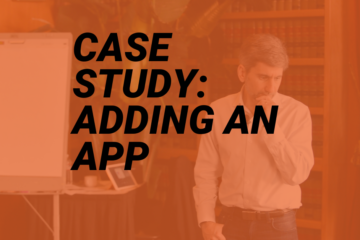This case study covers how to expand into new geographic areas – whether as a new owned location or if you’re franchising.
Transcript:
Raj: Hi there I’m Raja. And welcome to another case study. I’m here with Hannah Mears and Hannah, we’ve got an interesting one today. Something useful for anyone looking to make their demand generation more predictable? So what’s the case study we have today?
Hannah: Yes. So Raj, today our profile says, “I run a mobile windshield replacement business. If your car has had a broken windshield, instead of going to a glass repair shop, you can call us and we’ll come right to you. We successfully covered two cities in Arizona. Now with that being said, the situation is because we’ve been successful in our locations. We want to franchise our concept across the US. Currently, most of our businesses come from Yelp. We don’t pay for Yelp ads. We are listed there and get our business from people searching for windshield repairs. We probably also get some business from Google, my business listings, but we’re not sure how much.” So before we go any further to dive into this talk about how different franchising can be, because that’s something we really haven’t talked a lot about yet.
Raj: That’s true. Franchising, if you’re not familiar with it, is you make a template business. And it’s a business that you’ve got working in preferably multiple locations already. Usually, you don’t want a franchise if you’ve just got one up and running. And then you’re essentially cloning the business and having other folks buy into it. You become a franchise holder and you own the brand and some rules around how they use the brand and you give them a template for opening a business. It’s actually for the franchise buyer, a fantastic way to kind of be a pseudo entrepreneur because they get to own their own business, but they’ve all of the frameworks around it. In this situation, we’re talking about this windshield repair business that sounds like they’re successful in a couple of locations in Arizona. They want to offer other people the opportunity to do it in other cities. They can open it up for States, it doesn’t matter. But what’s the good takeaway from this, whether or not you’re a franchise owner or whether or not you were a franchise operator rather, or whether you’ve got a multi-location business. The important thing to take away is what we’re going to talk about is relevant whenever you’re opening up another location. So Hannah, do you think that I do that description, Okay? Does that all make sense?
Hannah: Perfect! So anyway, we’ve dealt with people wanting to relocate or come internationally, but now we’re talking about franchising. So a bunch of concepts is being covered, but the question is directly related to our windshield repair business profile that we have right now. They said, “When we start franchising, we’ll need to help the franchises generate new business. What’s the best way to do that? Should we just give up? The Yelp listings or is there something else we should be doing?” So this will apply to any, like you said, multi-location business, including franchises in particular. How do they need to start thinking about generating new business for new locations? That seems like kind of a hefty task to take on. Am I right?
Raj: Yeah It is. Because if you just set up the new location and you don’t do anything to generate business, how do you know what’s going to come? And that could be a big die roll. And now this is a mobile business. So maybe their infrastructure cost is less. And they’ve got a truck instead of having to open up a physical location. If you’re opening a physical location, certainly a big investment. You’ve got your rent or your mortgage. If you’re buying a location, you’ve got an outfit, everything. You’d have to hire staff. So there’s a big investment and you want certainty. The key to this in any new location is a process. Especially in a franchise because a franchise is a template and the process is important. And in fact, demand generation is perhaps the most important part of that template.
Obviously, you have to have customer delivery and you have to deliver the service or the product. But the important thing is that you can actually get customers to it or else the whole thing just doesn’t work. Now they’re doing Yelp. And one of the things with organic, which is so they’re not paying for Yelp ads, they’ve just got a Yelp listing, is you don’t know what’s going to work in the other locations. It might have been that they were early on Yelp and they happen to do well in these two locations. And they’re another franchise location that will be competing against a whole bunch of others and they won’t be so successful. So the key is really to be programmatic. So to have a program that can be duplicated to make everything predictable because, predictability, predictable sales, that’s, what’s going to be the determinant of successful failure.
Hannah: But predictability, that’s kind of a strong word we’re using here. Predictability and creating customers sounds like a fantasy. Yes, we can predict exactly who’s coming. We can look in that crystal ball and see what customers we’re going to have, but is it a fantasy to some business owners, or is it actually attainable? You tell us, Raj.
Raj: That’s the million-dollar question for everyone, right? Can I have predictable sales? What I will start by saying is that if you’re using a traditional approach, it’s usually, or often is not the best route and often fails. If you’re not tied to real numbers and here, we’ve got this particular case study, they’re using some online marketing methods, but they’re all organic. And they clearly don’t have numbers because they’re asking the question and they don’t have certainty around it. What I will say, what will not work is if you’re really just focused on PR or image marketing, ego marketing. A lot of the old-school stuff that you see I’ll hire a PR agency, or I’ll do one big event as a launch party, or I’ll just have an ad that’s got the name of my business and really it’s about the ego of a business owner rather than driving a result.
Those are usually, especially with today’s online marketing, destined to fail. And then the last part to address this one is you can’t succeed without all of the elements. Any demand generation initiative, they have to know how to do the creative, the media buying. You have to do the media planning and without all those things working together, you can’t have predictability. So really getting all of those elements together to get predictability and not just randomly doing actions that are hoped for results. You can make it predictable. So the answer is yes, you can, but you have to have all the elements lined up and not just view PR or ego-based marketing.
Hannah: Yeah. And in a perfect world, we’d love to do all of this absolutely unflawed. Go through it with perfection, but let’s revisit the theme of this question. What are some of the big mistakes people make when trying to open a new location?
Raj: Yeah, the biggest one is they’re relying on the location. And obviously for anything physical, if you’re doing a restaurant or something, location does matter. It absolutely matters, but the location is not going to be the sole determinant of whether you succeed or fail. And so you can’t blame the location. If it fails, you have to look at the totality of it. That’s one thing, but what have you done again, programmatically from a marketing perspective to generate demand for that location. You’ll want to test it and you need to test before you open. Even before you opened the location, have you done a few test marketing pieces? See if people are responding or getting there before you’ve made a big investment. And have you controlled variables? Because if you’re testing a new campaign, you’re saying, “Oh, I gotta launch this new location. And now I’m going to try this new campaign with a new location.”
Well, wait a minute. If you’re a good scientist, you don’t want to test multiple variables at once. You don’t want to test something, that’s a new location unproven. You don’t own how the market is going to react to a new campaign. So new campaign, creative, you haven’t used it before a new audience. So all of those things now you don’t know which one is working and what’s not. So what you want to do is a test on existing locations. So almost pretend like you’re going to launch your existing location, see what the response is. And then you have a benchmark. Now you’re opening up a new location. You’re not going to make those ones.
Hannah: It’s like going back to fifth-grade science class never took more than one variable. That feels like right here. But it’s important to have this system for generating demand. How did they go about choosing how to advertise? Because that’s something that’s a little different in itself.
Raj: Yeah, it is. And how you choose to advertise. It’s going to be based on what you’re advertising and to whom. So you can’t just use the same hammer for every single nail. You have to look at it in this case, we’re advertising something, which you don’t know the customer in advance. And there are several kinds of businesses like that. For instance, a locksmith, you can’t predict who’s going to get themselves locked out of the house. So it’s very hard for them to do anything other than a certain kind of advertising because you can’t do a direct mail piece unless you’re nailing everybody. So in this case, we’re dealing with a windshield repair. Now, it would be great if we could predict when we’re going to have a broken windshield so we can plan for it. But as we all know, we can’t do that.
So you can’t target based on many other things that some businesses can target based on age or gender or location or stage of life and things like that. Here, you can’t really do it other than it’s someone who has a car. You have to get really one of two choices: you can do brand and really just dominate an area or a group of people. And they’ll just know you to think of you when they think about this problem. In this case, if I need my windshield replaced. And that’s one, it’s just to dominate the brand. Well, the other is search because when someone has this problem, they’re going to search for an answer and they’ll either get it from their insurance company, like provider referral, or they’re going to search for the solution online and perhaps get it reimbursed by the insurance.
So here, we really need to make that choice. And it’s hard to do that without knowing the economics of the business and how much profit they’re pulling in and how much they can afford to brand. But it’s either going to be regular Google ads because that’s someone’s searching. So, you know if they’re actually looking for the thing well, or serving YouTube ads based on search queries, or they’re going to have to dominate an entire area with branding ads, which is way more expensive, but it can work. So it really one of the most wonderful, it depends on answers.
Hannah: Yeah. You mention something, the target audience. And I think that’s something we’ve talked about in just about every single profile we’ve done because that becomes a huge aspect when you’re looking to rebrand or relocate, whatever it may be. So when you talk about the term targeting, there’s also retargeting, and I know you’ve touched on it, but can you just describe a little bit more in-depth what that term means and how it’s an effective business?
Raj: Yeah. Great catch there Hannah, because retargeting is a key part of this. So retargeting is when someone visits your, let’s say your website or watches a video online, you can advertise just to the people who have made that first visit or made that first click or watch that video. And why that’s really interesting is for any advertisers not doing it, it’s essentially these people already have intent. So if they’ve gone to your website because they want X, Y, or Z, you know they’re interested in it. And then if you’re advertising, re-targeting those people, you know that there’s a higher likelihood that they’re going to convert to customers, or if they’ve watched the video of yours, the clue interested in the subject matter. Then you can follow up. So some of those profitable campaigns you can run are actually not targeting new people, but are retargeting people who you know are considering your product or service.
Hannah: So overall though, it doesn’t sound like it’s a great idea to launch a new location without nailing down how it will get business 100%. Is that correct?
Raj: That is correct. So you need certainty to launch without a really well-defined plan that has got some data behind. It would be a big mistake. So you definitely want to nail that demand generation plan before launching a new location.
Hannah: So overall though, how long will it take for them? With demand generation programs, How long will that take before they can launch this new location? Is there a certain process they should be following when doing that and thinking about it?
Raj: Yeah. I think the important thing to realize is this is not about time. And I know business owners are thinking about time because maybe they’ve got debt service that they have to take care of and things like that. But ultimately if you’re starting from cold, like this particular case study is to try to predict how long it’s going to take would probably be a mistake because what they want is a certainty. So if anything I would recommend taking the time it takes to get this certainty about if you’re putting a dollar in, are you getting more than a dollar out. What are the results, testing it with current locations so that you know, “I can get the following results when I launch.” If you do that, if you launch before knowing that, or at least having a decent amount of predictability then really it’s, you’re risking the entire new location, not succeeding. So it is about predictability. That’s the important thing. And could it take months? Yes. Could it take years? Maybe. If you’re really focused on it and you have a good team, you should be able to do it in shorter than that. But ultimately I would say, go for certainty rather than time as the measure of when you watch that next location.
Hannah: It seems as though the theme here is to be predictable because it’ll pay off. The last thing you want to do is spend so much time on something that it fails. So make sure your time is being used effectively and efficiently, and it will pay off. Because also, the other thing you don’t want to do here is rush something, and then you have to go back and fix it all again. So Raj, your overall main point that this company, this windshield business needs to take away in order to start franchising.
Raj: I would say slow down to speed up. So really slow down, be disciplined about the process of understanding demand generation, know your numbers. If you’re not marketing folks, get marketing help from people who understand how to put together that campaign creative and the media planning and the media buying to actually make it successful. Test on an existing location, get some baselines, and increase your confidence in this. The very fact that you’re asking this question is a good thing, but it also speaks to the fact that maybe you want to nail this down a little further before making a huge investment whether it’s a franchise or an owned location and making a big risk. So definitely slow down to speed up is my general advice here.
Hannah: Hopefully the next time my windshield and my car is cracked. This is who I will be calling based on all the wonderful knowledge and insight that Raj and I have delivered today. Especially you, Thank you so much, Raj. Thanks for everyone tuning in. Again, if you have questions, concerns about your businesses, how you can grow your dreams, your plans, your fantasies, let us know, and we can help you get there. Thanks so much!
Raj: Until next time.



